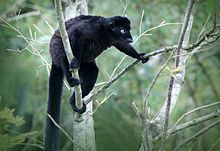Eulemur flavifrons
| Blue-eyed black lemur | |
|---|---|
 |
|
| Scientific classification | |
| Kingdom: | Animalia |
| Phylum: | Chordata |
| Clade: | Synapsida |
| Class: | Mammalia |
| Order: | Primates |
| Suborder: | Strepsirrhini |
| Family: | Lemuridae |
| Genus: | Eulemur |
| Species: | E. flavifrons |
| Binomial name | |
|
Eulemur flavifrons Gray, 1867 |
|
 |
|
| Distribution of E. flavifrons | |
| Synonyms | |
|
|
The blue-eyed black lemur (Eulemur flavifrons), also known as the Sclater's lemur, is a species of true lemur. It can attain a body length of 39–45 cm, a tail length of 51–65 cm- a total length of 90–100 cm, and a weight of 1.8-1.9 kg. Being a primate, it has strong hands with palms like a human, which have a rubbery texture to give it a firm grip on branches. Its tail is longer than its body and non-prehensile.
Like many of the species in the Eulemur genus, the blue-eyed black lemur is sexually dichromatic. Males are solid black in color, with the hairs sometimes tinged brown at the roots. Females are reddish-brown in color with their underside and outline of their face a lighter tan. They have a dark brown or gray muzzle and the back of their hands and feet are a similar dark color. Both sexes have blue eyes, hence the common name, and are one of the only primates other than humans to consistently have blue eyes. The eyes can range in color from shocking electric blue, a light sky-blue, or a softer gray-blue.
Although the blue-eyed black lemur and the black lemur look similar, they can be differentiated by the blue eyes and lack of prominent ear tufts of this subspecies, while the black lemur has orange-red eyes and long, spiky cheek hairs. In the Manongarivo Special reserve, where the range of the two species overlap, there is report of hybridization between the two species, but the resulting offspring always have orange eyes. Until 2008, the blue-eyed black lemur was considered a subspecies, E. macaco flavifrons, of the black lemur.
This true lemur has not been studied intensively in the wild, but it is known to be fairly social. Group sizes vary four to eleven individuals on average. Females are dominant as in most lemur species, and there are usually more males than females in each social group. The blue-eyed black lemur is thought to be polygynous. Females give birth to one or two offspring in June or July, after a gestation of 120 to 129 days. The young are weaned after about 5–6 months, and reach maturity at about 2 years of age. It may live between 15–30 years in captivity, with little data recorded on their longevity in the wild. It demonstrates a cathemeral activity pattern, being awake sporadically throughout the day. The occasional nighttime activities are thought to be based on the intensity of the moonlight.
...
Wikipedia

